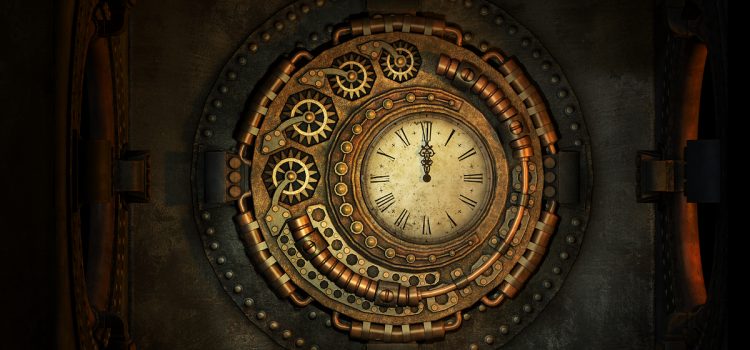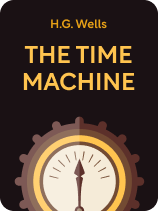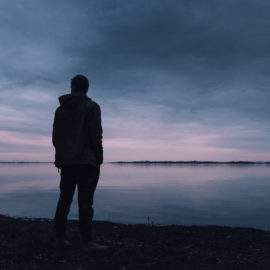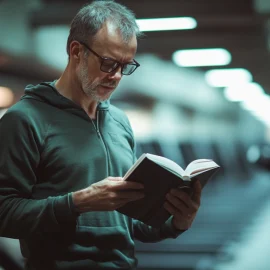

This article is an excerpt from the Shortform book guide to "The Time Machine" by H.G. Wells. Shortform has the world's best summaries and analyses of books you should be reading.
Like this article? Sign up for a free trial here.
How does The Time Machine end? Is the ending the same in the 1960 movie adaptation?
H.G. Wells’s The Time Machine begins with a scientist showing off a time machine he invented. He travels to the future, where humanity has evolved into two species. He goes even further and sees the end of the world. He returns home to tell his friends what he’s seen, but that’s not the very end of the story.
Keep reading to learn about The Time Machine’s ending.
The Fate of the World
The Time Machine’s ending entails what the Time Traveller experienced after he escaped from the Morlocks in the year 802701. He leaps many millennia further into the future and sees that the sun is getting bigger and redder. He briefly stops every thousand years and concludes that the entire Earth is slowly dying.
Finally, about 30 million years into the future, the air is thin and extremely cold. The sun is now fully red and takes up a large section of the sky. The Time Traveller sees nothing living except for some mosses and lichens and a creature that looks like a black octopus roughly the size of a soccer ball flopping weakly in the ocean shallows. It begins to snow, and then the sky turns dark. He realizes he’s seeing a solar eclipse.
The Time Traveller is horrified and sickened by this bleak view of the end of the world. Eventually, the eclipse ends, and the returning light brings the Time Traveller to his senses. He returns to his machine and starts the journey back to his own time.
Back to the Present
The Time Traveller lands his machine on the same date he’d started from, at about eight o’clock in the evening. He hears the sounds of the dinner party happening just outside his laboratory, so he greets his guests, cleans himself up, and joins them.
The Time Traveller tells the dinner guests about his journey through time and adds that he doesn’t expect them to believe him. So, as evidence of his travels, he places two strange white flowers—a gift from Weena—on the table. He also points out that the time machine is stained with dirt and grass, which would be impossible had it never left his laboratory.
The guests eventually leave, deep in discussion about what he told them. The narrator can’t sleep that night, and the next day he returns to the Time Traveller’s house uninvited. He finds the Time Traveller getting ready for another journey through time. The Time Traveller says he’ll be back in half an hour, and this time he’ll bring conclusive proof that his story was true.
The story ends with the narrator explaining that three years have passed since that day. The Time Traveller never returned, and the narrator now thinks that he never will. He wonders whether the Time Traveller is still wandering through time or if he died during his travels.
(Shortform note: The 1960 movie adaptation of The Time Machine has a more conclusive and happier ending—the Time Traveller returns to the future to keep searching for Weena and to help the Eloi start a new culture for themselves.)
Furthermore, the narrator is still deeply upset by what he’d heard about the end of humanity and, later, the end of the world. His only comfort is the two flowers from Weena, which he kept for himself after the Time Traveller left on his second journey. To the narrator, the flowers symbolize the fact that people will always have the capacity for love and gratitude, even after they’ve lost everything else that makes them human.
| The Narrator’s Existential Crisis At the end of this story, the narrator is suffering from an existential crisis. In other words, he’s trying to come to terms with the knowledge that, ultimately, nothing he or anyone else does will matter. As the Time Traveller saw, eventually humans will go extinct and the world will end, and there will be no sign that we ever lived at all. The purpose of life (or lack thereof) is the central issue of many different branches of philosophy. Existentialism teaches that life has no ultimate meaning or purpose, and therefore each of us must create our own. Instead of being told our purpose by an outside authority (such as parents, teachers, or religion), we’re all personally responsible for creating our own purpose and striving to fulfill it. The narrator has taken the first step toward finding his own meaning in life, as existentialism says he must do: He’s concluded that kindness is at the core of humanity, and it’s the one thing that will remain after our strength and intelligence are gone. To move past his crisis, he needs to decide how that realization translates to a purpose in life. For example, he might conclude that his purpose should be to spread kindness and happiness however he can. If humanity is ultimately doomed, then perhaps the only reasonable purpose in life is to help people enjoy the time they have. |

———End of Preview———
Like what you just read? Read the rest of the world's best book summary and analysis of H.G. Wells's "The Time Machine" at Shortform.
Here's what you'll find in our full The Time Machine summary:
- An overview and analysis of H.G. Wells's 1895 science fiction novel
- A look at the science behind the story—what's real and what's fiction
- The literary techniques and symbolism Wells used to craft the story







Excellent – not only your assessment- but the attention you paid to what is possibly my favorite book; Would love to see what you would say about a couple more of my favorites- “Invisible Man” by Ralph Ellison, and I am also ( as a special education teacher) fascinated by “Flowers for Algernon”
I think we all need to ascend to The 5th dimension and leave the third dimension behind meaning that we won’t be stuck in materialism and will be more spiritual in the end we will have to evolve to The 5th dimension in order to be capable of not ending
Love to hear your interpretation of The Martian Chronicles.